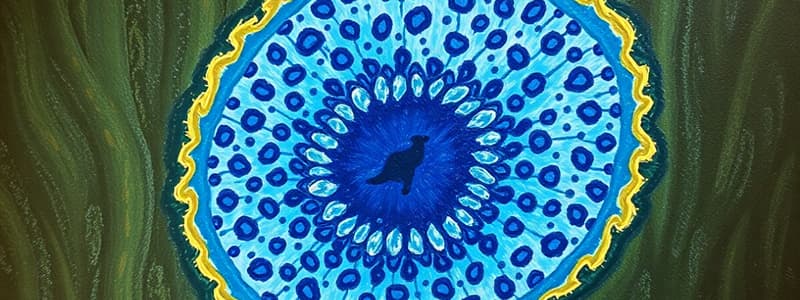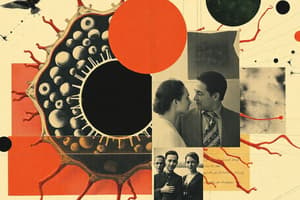Podcast
Questions and Answers
What is a key characteristic of a selectively permeable membrane?
What is a key characteristic of a selectively permeable membrane?
- It allows the passage of only small molecules.
- It allows the passage of certain substances based on size and type. (correct)
- It allows all substances to pass through.
- It allows the passage of only large molecules.
Which of the following is NOT a reason for cell division?
Which of the following is NOT a reason for cell division?
- Production of energy for the cell (correct)
- Growth of an organism
- Replacement of damaged cells
- Reproduction of organisms
What cellular structure serves as a transport network for materials within the cell?
What cellular structure serves as a transport network for materials within the cell?
- Endoplasmic reticulum (correct)
- Cell wall
- Golgi body
- Vacuole
Which of the following features is characteristic of asexual reproduction?
Which of the following features is characteristic of asexual reproduction?
Which organelle is responsible for protein synthesis in the cell?
Which organelle is responsible for protein synthesis in the cell?
What is the primary function of interphase in the cell cycle?
What is the primary function of interphase in the cell cycle?
Which of the following is NOT a characteristic of anaphase?
Which of the following is NOT a characteristic of anaphase?
What is the key difference between a benign and a malignant tumor?
What is the key difference between a benign and a malignant tumor?
Which cellular structure is responsible for energy production and is abundant in highly active cells like muscle cells?
Which cellular structure is responsible for energy production and is abundant in highly active cells like muscle cells?
During which stage of the cell cycle does the cytoplasm divide, creating two daughter cells?
During which stage of the cell cycle does the cytoplasm divide, creating two daughter cells?
Which of the following is NOT a function of connective tissue?
Which of the following is NOT a function of connective tissue?
What is the primary function of muscle tissue?
What is the primary function of muscle tissue?
Which type of tissue transmits information around the body?
Which type of tissue transmits information around the body?
What is a stem cell?
What is a stem cell?
What is cellular differentiation?
What is cellular differentiation?
What is the primary function of saliva in the digestive process?
What is the primary function of saliva in the digestive process?
Which part of the digestive system absorbs the majority of nutrients from digested food?
Which part of the digestive system absorbs the majority of nutrients from digested food?
What is the primary function of the large intestine in the digestive process?
What is the primary function of the large intestine in the digestive process?
Which of the following is NOT a function of the stomach in food digestion?
Which of the following is NOT a function of the stomach in food digestion?
What type of specialized proteins are produced in the stomach lining to aid in digestion?
What type of specialized proteins are produced in the stomach lining to aid in digestion?
What is a key characteristic of sexual reproduction?
What is a key characteristic of sexual reproduction?
What describes the speed of asexual reproduction compared to sexual reproduction?
What describes the speed of asexual reproduction compared to sexual reproduction?
In which cellular process does water specifically move across a membrane?
In which cellular process does water specifically move across a membrane?
Which stage of the cell cycle involves the formation of a new cell wall?
Which stage of the cell cycle involves the formation of a new cell wall?
During which phase does the membrane of the nucleus completely dissolve?
During which phase does the membrane of the nucleus completely dissolve?
What is the primary function of the blood?
What is the primary function of the blood?
What is a fundamental principle of cell theory?
What is a fundamental principle of cell theory?
What is the role of the heart in the circulatory system?
What is the role of the heart in the circulatory system?
Which feature differentiates prokaryotic cells from eukaryotic cells?
Which feature differentiates prokaryotic cells from eukaryotic cells?
Which of the following is NOT a function of the blood?
Which of the following is NOT a function of the blood?
What is the main role of the lungs in the body?
What is the main role of the lungs in the body?
What is one characteristic unique to plant cells compared to animal cells?
What is one characteristic unique to plant cells compared to animal cells?
Which statement accurately describes the relationship between the heart, blood, and lungs?
Which statement accurately describes the relationship between the heart, blood, and lungs?
Which of the following statements accurately describes animal cells?
Which of the following statements accurately describes animal cells?
What is a characteristic that distinguishes a plant cell's structure?
What is a characteristic that distinguishes a plant cell's structure?
What is the function of the epiglottis in the respiratory system?
What is the function of the epiglottis in the respiratory system?
Which of the following is NOT a benefit of organ transplantation?
Which of the following is NOT a benefit of organ transplantation?
Which of these is a potential risk associated with organ transplantation?
Which of these is a potential risk associated with organ transplantation?
What is the name of the tube that carries air from the nose and mouth to the lungs?
What is the name of the tube that carries air from the nose and mouth to the lungs?
Which of the following is NOT a function of the musculoskeletal system?
Which of the following is NOT a function of the musculoskeletal system?
What is the role of the brain in the nervous system?
What is the role of the brain in the nervous system?
Which organ system primarily interacts with the respiratory system?
Which organ system primarily interacts with the respiratory system?
What are the three main tissue types found in plants?
What are the three main tissue types found in plants?
Which structure in the nervous system is responsible for sending signals around the body?
Which structure in the nervous system is responsible for sending signals around the body?
Which of the following is NOT a function of plant roots?
Which of the following is NOT a function of plant roots?
What is the main function of xylem in plants?
What is the main function of xylem in plants?
How do phloem cells differ from xylem cells?
How do phloem cells differ from xylem cells?
What role do guard cells play in the process of gas exchange?
What role do guard cells play in the process of gas exchange?
Which process is summarized by the equation: Carbon dioxide + Water → Glucose + Oxygen?
Which process is summarized by the equation: Carbon dioxide + Water → Glucose + Oxygen?
What is the primary site for gas exchange in a leaf?
What is the primary site for gas exchange in a leaf?
Flashcards
Sexual Reproduction
Sexual Reproduction
Reproduction involving two parents, combining their genetic material to create offspring with variation.
Asexual Reproduction
Asexual Reproduction
Reproduction involving a single parent, creating genetically identical offspring.
Diffusion
Diffusion
The movement of molecules from an area of high concentration to an area of low concentration.
Osmosis
Osmosis
Signup and view all the flashcards
Cell Cycle
Cell Cycle
Signup and view all the flashcards
Cell Theory
Cell Theory
Signup and view all the flashcards
Prokaryotic Cell
Prokaryotic Cell
Signup and view all the flashcards
Eukaryotic Cell
Eukaryotic Cell
Signup and view all the flashcards
Plant vs. Animal Cells
Plant vs. Animal Cells
Signup and view all the flashcards
Organelles
Organelles
Signup and view all the flashcards
What is selective permeability?
What is selective permeability?
Signup and view all the flashcards
What does the endoplasmic reticulum do?
What does the endoplasmic reticulum do?
Signup and view all the flashcards
Why do cells divide?
Why do cells divide?
Signup and view all the flashcards
What makes sexual reproduction unique?
What makes sexual reproduction unique?
Signup and view all the flashcards
What's special about asexual reproduction?
What's special about asexual reproduction?
Signup and view all the flashcards
Anaphase
Anaphase
Signup and view all the flashcards
Cytokinesis
Cytokinesis
Signup and view all the flashcards
Interphase
Interphase
Signup and view all the flashcards
Benign Tumor
Benign Tumor
Signup and view all the flashcards
Malignant Tumor
Malignant Tumor
Signup and view all the flashcards
Cellular Differentiation
Cellular Differentiation
Signup and view all the flashcards
Stem Cell
Stem Cell
Signup and view all the flashcards
What are the functions of connective tissue?
What are the functions of connective tissue?
Signup and view all the flashcards
What is the main function of muscle tissue?
What is the main function of muscle tissue?
Signup and view all the flashcards
What is the primary role of nerve tissue?
What is the primary role of nerve tissue?
Signup and view all the flashcards
Epiglottis Function
Epiglottis Function
Signup and view all the flashcards
Organ Transplantation Benefits and Risks
Organ Transplantation Benefits and Risks
Signup and view all the flashcards
What is the function of the musculoskeletal system?
What is the function of the musculoskeletal system?
Signup and view all the flashcards
What is digestion?
What is digestion?
Signup and view all the flashcards
What is the role of enzymes in digestion?
What is the role of enzymes in digestion?
Signup and view all the flashcards
What is the main function of the small intestine?
What is the main function of the small intestine?
Signup and view all the flashcards
What happens in the large intestine?
What happens in the large intestine?
Signup and view all the flashcards
What is the function of saliva in digestion?
What is the function of saliva in digestion?
Signup and view all the flashcards
What is the heart's role in the body?
What is the heart's role in the body?
Signup and view all the flashcards
What are the key functions of blood?
What are the key functions of blood?
Signup and view all the flashcards
What is the primary function of the lungs?
What is the primary function of the lungs?
Signup and view all the flashcards
Why is oxygen important for the body?
Why is oxygen important for the body?
Signup and view all the flashcards
What is carbon dioxide and what happens to it?
What is carbon dioxide and what happens to it?
Signup and view all the flashcards
What are the main organs of the nervous system and their functions?
What are the main organs of the nervous system and their functions?
Signup and view all the flashcards
What is a neuron?
What is a neuron?
Signup and view all the flashcards
Which system tells us when we need to eat or drink?
Which system tells us when we need to eat or drink?
Signup and view all the flashcards
Which organ system interacts with most other systems?
Which organ system interacts with most other systems?
Signup and view all the flashcards
What are two systems that interact with the circulatory system?
What are two systems that interact with the circulatory system?
Signup and view all the flashcards
What is the plant transport system?
What is the plant transport system?
Signup and view all the flashcards
What are stomata?
What are stomata?
Signup and view all the flashcards
What are guard cells?
What are guard cells?
Signup and view all the flashcards
What is photosynthesis?
What is photosynthesis?
Signup and view all the flashcards
How are leaves structured for photosynthesis?
How are leaves structured for photosynthesis?
Signup and view all the flashcards




